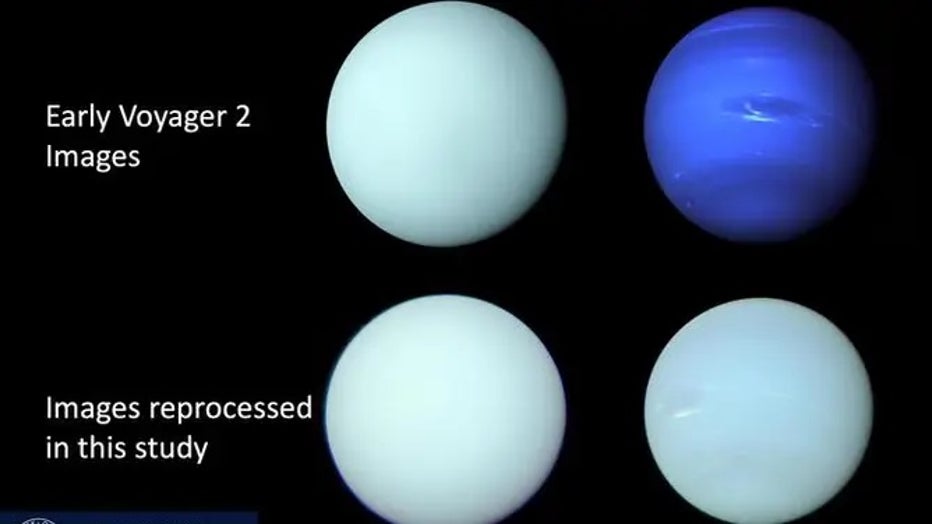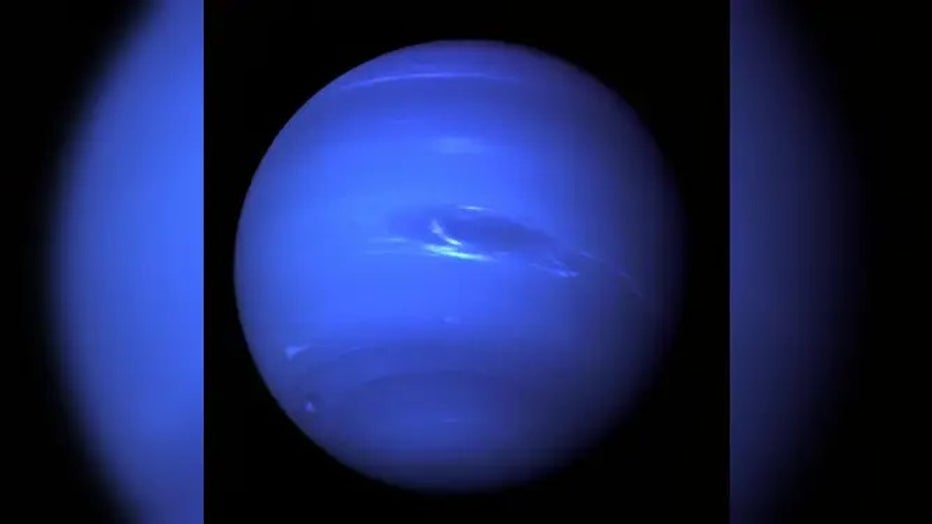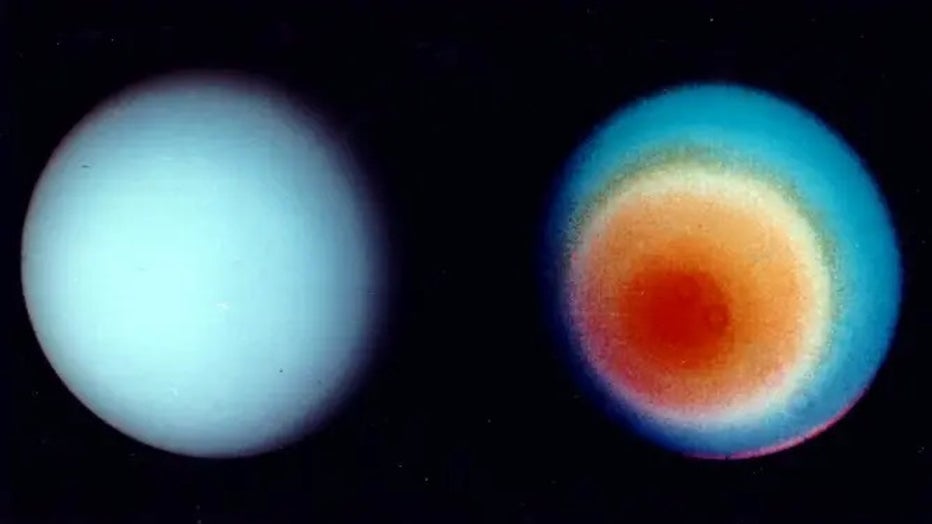Astronomers reveal what Uranus and Neptune really look like
The way most of the public thinks Neptune and Uranus look, especially "big blue" Neptune, does not likely resemble what astronomers say these icy giant worlds actually look like.
The planets of Uranus and Neptune have long been pictured as cold blue worlds thanks to the only spacecraft flyby of both planets more than 30 years ago, with Neptune as a deep blue and Uranus a much paler blue. According to a study published Thursday in the Monthly Notice of the Royal Astronomical Society, our solar system’s most distant planets are more similar in color to a greenish blue.
A research team used data from instruments on the Hubble Space Telescope and the European Southern Observatory's Very Large Telescope (VLT) that records the spectrum of colors for each pixel. According to the European Space Agency, the MUSE instrument on the VLT provides a 3D dataset where each pixel of the image has a full spectrum of light and is capable of measuring more than 4,000 colors.
URANUS: GET TO KNOW THE 7TH PLANET FROM THE SUN
Astronomers used the data to re-balance the composite color images recorded by Voyager 2 and the Hubble Space Telescope’s Wide Field Camera 3 to reveal the "true color" of Neptune and Uranus. This work revealed that both planets are a similar shade of greenish blue, according to the study.

On top: images from Voyager 2 of Uranus and Neptune released shortly after the flybys in 1986 and 1989. On the bottom: both reprocessed images used for the study to determine the best estimate of the true colors of both planets. (Image credit: Patric
Why Neptune is known as "big blue"
The most widely used image of Neptune is from NASA’s Voyager 2 mission, taken in 1989. The study authors said the images of Neptune were enhanced to show more features on the planet, including clouds and winds.

This picture of Neptune was produced from the last whole planet images taken through the green and orange filters on NASA's Voyager 2 narrow angle camera. The images were taken at a range of 4.4 million miles from the planet, 4 days and 20 hours befo
"Even though the artificially-saturated color was known at the time amongst planetary scientists – and the images were released with captions explaining it – that distinction had become lost over time," said study author Patrick Irwin of the University of Oxford.
According to NASA, photographing Neptune was challenging because the planet receives 0.0001 times the sunlight of Earth, and the Voyager spacecraft was moving at speeds of about 60,000 mph during the flyby.
NASA’s models of Neptune in 2023 are a much lighter blue, more in line with the planet’s actual color that was revealed in the study.
CLOUDY WEATHER ON NEPTUNE INFLUENCED BY SOLAR CYCLE, HUBBLE DATA SHOWS
According to the study, Neptune does have a "slight hint" of blue, and models show this is because of a thinner layer of haze on the planet.
Seasons on Uranus

These two pictures of Uranus were compiled from images recorded by Voyager 2 on Jan. 10, 1986, when the NASA spacecraft was 18 million kilometers (11 million miles) from the planet. The picture on the left has been processed to show Uranus as human e
The researchers behind the study said they have also solved the mystery of Uranus’ color changes during its 84-year orbit of the Sun.
Measurements from the Lowell Observatory in Arizona recorded in blue and green wavelengths show Uranus is a little greener during summer and winter when one of its poles is pointed toward the Sun. However, during its equinoxes, it is bluer with the Sun over the equator.
LONELY NEPTUNE'S RINGS SHINE BRIGHT IN JAMES WEBB SPACE TELESCOPE IMAGES
The researchers came up with another model to compare the colors of the polar and equatorial regions, finding that the polar regions are more reflective at green and red wavelengths than at blue wavelengths because methane is about 50% less near the poles than the equator.

Color variations on Uranus during seasonal cycles
Video from the University of Oxford shows the color changes through the season on Uranus. (FOX Weather)
Another model added a "hood" of gradually thickening ice observed over the summer, which helped fully explain the color change. Astronomers believe this haze is made up of methane ice particles, which increase the reflection of green and red wavelengths at the poles. This explains why Uranus is greener during the solstice.
"In this way, we have demonstrated that Uranus is greener at the solstice due to the polar regions having reduced methane abundance but also an increased thickness of brightly scattering methane ice particles," Irwin said.
The video above shows the seasonal changes to the planet's color.

Image of Uranus from the NIRCam (Near-Infrared Camera) on NASA’s James Webb Space Telescope. (NASA / FOX Weather)
More recently, both ice giants have been observed by NASA’s James Webb Space Telescope. Those images were in infrared light, not true color.
NEW PHOTO OF URANUS TAKEN BY WEBB TELESCOPE SHOWS VIVID DETAILS OF 7TH PLANET
The images of Uranus released by NASA in 2023 included a representative-color image combining two filters. JWST was also used to study Neptune in 2022, revealing new details of the planet’s icy rings.

Webb’s Near-Infrared Camera (NIRCam) image of Neptune, taken on 12 July 2022, brings the planet’s rings into full focus for the first time in more than three decades. The most prominent features of Neptune’s atmosphere in this image are a series of b
Uranus and Neptune haven’t had a spacecraft visitor since NASA’s Voyager 2 mission more than 30 years ago. The study authors said that if a dedicated spacecraft were to orbit Uranus, it would only get a glimpse of a Uranian year. It takes Uranus 84 Earth years to orbit the Sun.
Study co-author and planetary scientist Leigh Fletcher of the University of Leicester said a mission to Uranus is a "high priority for space agencies in the decades to come."
NASA has plans to explore a possible flagship mission, including an orbiter to Uranus and a probe dropped into the atmosphere in the next decade.


